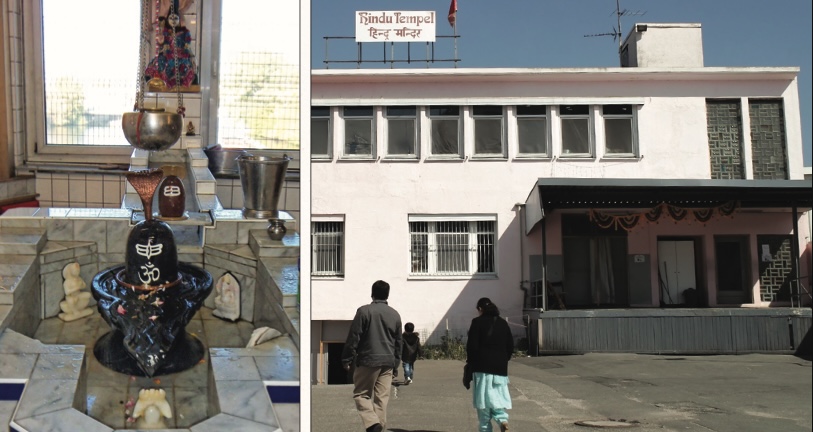Among Germany’s 48 Hindu temples, the one established by the Hindu community of Afghanistan, in 1999 at Billstrasse 77 in Hamburg, Germany, has a unique character due to the history of its founders. I made this discovery in September 2011 on a trip from my home in Kathmandu, Nepal, to do some research at the German Institute of Global and Area Studies.
FLIGHT FROM PERSECUTION
Many of Germany’s Hindus are refugees from Afghanistan, where Hindus have been methodically persecuted and tortured since the reign of King Zhahir Shah, 1930-1973. Their status became grave after the invasion by the Soviet Union and the rise of the Taliban. From 1980 onward, Afghan Hindus were religiously persecuted as “kafirs.” Afghanistan’s one million Hindus had two choices: either embrace Islam or leave the country. Rather than compromise their religion, the majority opted to emigrate–risking their lives and leaving behind land and property that had belonged to their families for generations. Most took refuge in Germany, Canada, USA, Holland, Russia, Italy, England and India. By the year 2000, it was estimated that only 531 Hindus remained in Afghanistan.
Approximately 2,000 Afghan refugee families live in Germany. The largest number (600 families) are in Hamburg, followed by Koln (450 families), Frankfurt (400 families) and Essen (200 families). Their emotional roots are in India. Most speak Hindi, follow the Indian calendar and believe in the purity of the Ganga and its sacred water. When they reached Germany, they had nothing to claim as their own. They had no shelter, no temple and no place for a social gathering. They have since established five Hindu temples and two Sikh Gurudwaras in Germany–in Hamburg, Essen, Koln and Frankfurt.
PROUD TO BE HINDU FIRST, AFGHAN SECOND
I happened to meet a Hindu Afghan on my first day in Hamburg. Having arrived and settled in the morning, I had a meal delivered in the afternoon by someone I assumed was Nepalese, as My landlord was a Nepali. But when I asked the gentleman a question in Nepali, he made is clear that he did not know that language, stating, “I am a Hindu, Suraj, from Afghanistan.” It was a refreshing surprise to hear someone so forthrightly introduce himself as Hindu!
A few days later, when I was traveling in a local boat at the Hamburg harbor, I asked an Indian-looking man to take my picture with my camera. He asked if I spoke Hindi, then introduced himself, in Hindi, as a Hindu Afghan. Once again I was surprised, since Indians and Nepalese rarely introduce themselves as Hindus. But Hindus from Afghanistan introduce themselves first as Hindu and only second as Afghan. It seems their tragic persecution has awakened a strong awareness and pride in their Hindu identity.
The faith of Afghan Hindus runs deep into the past. Hinduism has a long and glorious history in Afghanistan. In the Mahabharata period, some 5,000 years ago, the wife of Dhritarashtra, Gandhari, was from Kandahar. There is a famous Siva temple in Kandahar even to this day. The Hindus in this land followed Saivism, Vaishnavism and Shaktism, and the ancient rites of the Vedic fire worship were observed in Afghanistan for millennia.
THE TEMPLE–CENTER OF THE COMMUNITY
Now fascinated with Germany’s Hindu Afghans, I made a point to visit their temple in Hamburg. It was the eighth day of Navaratri, and a Vedic yagna (fire sacrifice) was being offered to Goddess Durga. You can catch a glimpse of the puja on YouTube, bit.ly/german-hindus [http://bit.ly/german-hindus]. In the temple, I saw magnificent murtis of many Gods and Goddesses, including Sita-Ram, Radha-Krishna, Siva-Parvati, Hanuman, Narsimha and Durga.
Built in 1997 at a cost of us$1.2 million, the temple is very active. On Sundays over 200 devotees attend–not only Afghan Hindus, but Indians and also German students who want to learn more about Hinduism. In addition to the daily worship, special weekly pujas and satsangs by the devotees, the temple celebrates most annual festivals such as Navaratri, Lakshmi puja, Basant Panchami, Holi, Mahasivaratri, Ramanavami and Krishnastami.
The temple has blossomed over the years, hosting many meditation, yoga and bhajan programs. In the future, they want to introduce more regular educational classes, including the study of Hindi. Many of the devotees shared that it is Hamburg temple that has kept Hindu unity intact, and their faith has been strengthened and fortified due to the religious freedom they enjoy in Germany.
I asked a number of temple devotees to share their vision of the significance of the temple. Radha Goswami: “Our community felt the need for a temple to promote Hindu religion and culture.” Ram Saha: “We wanted to have a temple as a place for discussing community-related problems.” Sita:”We had no place for social gatherings, marriage rites or performance of the death rituals. So we thought we should have a temple to meet these needs.” Ravindra: “We needed a temple to pass on the Hindu samskaras to the children. The temple is the place where the children are given practical demonstration as to how the samskaras are transmitted.”
It was Shanti who summed it up for me: “We wanted to build the temple for the protection and promotion of Sanatan Hindu Dharma. Dharma, for us, is above everything.”
